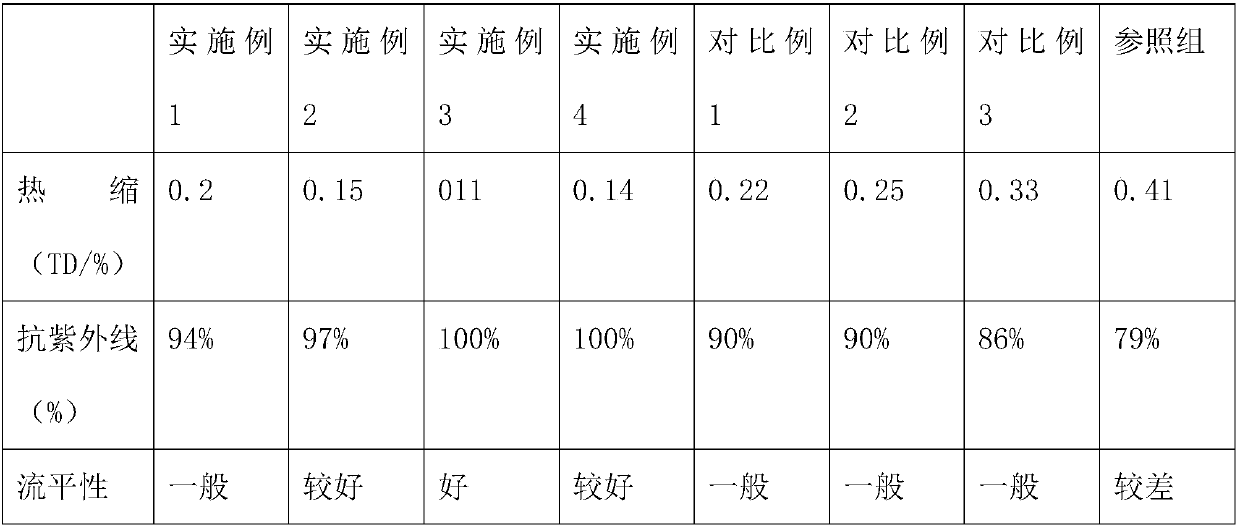Release material with low heat shrinkage and strong adhesive force
A technology with strong adhesion and release material, applied in the direction of wax coating, coating, etc., can solve the problems of large heat shrinkage, poor anti-ultraviolet ability, and insufficient adsorption ability, and achieve small heat shrinkage and strong anti-ultraviolet ability , The effect of low manufacturing cost
- Summary
- Abstract
- Description
- Claims
- Application Information
AI Technical Summary
Problems solved by technology
Method used
Image
Examples
Embodiment 1
[0017] A release material with small thermal shrinkage and strong adhesion, comprising the following raw materials in parts by weight: 10 parts of montanic acid wax, 2 parts of calcium carbonate, 6 parts of palm oil, 2 parts of silicon dioxide, 3 parts of water-based resin, 6 parts of wetting agent, 10 parts of thermoplastic elastomer resin, 2 parts of dioctyl maleate, 1 part of oleic acid amide, 15 parts of flame retardant, 2 parts of tailings.
[0018] Further, the flame retardant is an expandable graphite flame retardant.
[0019] Further, the wetting agent is ethanol.
[0020] Further, the specific steps of the manufacturing method of the release material with small heat shrinkage and strong adhesion are as follows:
[0021] S1. Put calcium carbonate, silicon dioxide, water-based resin, thermoplastic elastomer resin, and tailings into a pulverizer for pulverization. The pulverizer model is MTW175, and the output particle size is 150 mesh;
[0022] S2. Put the mixture obt...
Embodiment 2
[0026] A release material with small thermal shrinkage and strong adhesion, comprising the following raw materials in parts by weight: 13 parts of montanic acid wax, 3 parts of calcium carbonate, 8 parts of palm oil, 10 parts of silicon dioxide, 4 parts of water-based resin, 8 parts of wetting agent, 17 parts of thermoplastic elastomer resin, 5 parts of dioctyl maleate, 3 parts of oleic acid amide, 17 parts of flame retardant, 4 parts of tailings.
[0027] Further, the flame retardant is an expandable graphite flame retardant.
[0028] Further, the wetting agent is propylene glycol.
[0029] Further, the specific steps of the manufacturing method of the release material with small heat shrinkage and strong adhesion are as follows:
[0030] S1. Put calcium carbonate, silicon dioxide, water-based resin, thermoplastic elastomer resin, and tailings into a pulverizer for pulverization. The pulverizer model is MTW175, and the output particle size is 170 mesh;
[0031] S2. Put the ...
Embodiment 3
[0035] A release material with small thermal shrinkage and strong adhesion, comprising the following raw materials in parts by weight: 18 parts of montanic acid wax, 4 parts of calcium carbonate, 10 parts of palm oil, 15 parts of silicon dioxide, 6 parts of water-based resin, 11 parts of wetting agent, 25 parts of thermoplastic elastomer resin, 8 parts of dioctyl maleate, 6 parts of oleic acid amide, 23 parts of flame retardant, and 8 parts of tailings.
[0036] Further, the flame retardant is an expandable graphite flame retardant.
[0037] Further, the humectant is glycerin.
[0038] Further, the specific steps of the manufacturing method of the release material with small heat shrinkage and strong adhesion are as follows:
[0039] S1. Put calcium carbonate, silicon dioxide, water-based resin, thermoplastic elastomer resin, and tailings into a pulverizer for pulverization. The pulverizer model is MTW175, and the output particle size is 210 mesh;
[0040] S2. Put the mixtur...
PUM
 Login to View More
Login to View More Abstract
Description
Claims
Application Information
 Login to View More
Login to View More - R&D
- Intellectual Property
- Life Sciences
- Materials
- Tech Scout
- Unparalleled Data Quality
- Higher Quality Content
- 60% Fewer Hallucinations
Browse by: Latest US Patents, China's latest patents, Technical Efficacy Thesaurus, Application Domain, Technology Topic, Popular Technical Reports.
© 2025 PatSnap. All rights reserved.Legal|Privacy policy|Modern Slavery Act Transparency Statement|Sitemap|About US| Contact US: help@patsnap.com


